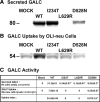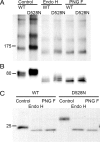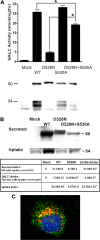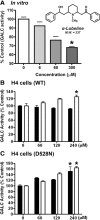Molecular characterization of mutations that cause globoid cell leukodystrophy and pharmacological rescue using small molecule chemical chaperones
- PMID: 20410102
- PMCID: PMC3278277
- DOI: 10.1523/JNEUROSCI.6383-09.2010
Molecular characterization of mutations that cause globoid cell leukodystrophy and pharmacological rescue using small molecule chemical chaperones
Abstract
Globoid cell leukodystrophy (GLD) (Krabbe disease) is an autosomal recessive, degenerative, lysosomal storage disease caused by a severe loss of galactocerebrosidase (GALC) enzymatic activity. Of the >70 disease-causing mutations in the GALC gene, most are located outside of the catalytic domain of the enzyme. To determine how GALC mutations impair enzymatic activity, we investigated the impact of multiple disease-causing mutations on GALC processing, localization, and enzymatic activity. Studies in mammalian cells revealed dramatic decreases in GALC activity and a lack of appropriate protein processing into an N-terminal GALC fragment for each of the mutants examined. Consistent with this, we observed significantly less GALC localized to the lysosome and impairment in either the secretion or reuptake of mutant GALC. Notably, the D528N mutation was found to induce hyperglycosylation and protein misfolding. Reversal of these conditions resulted in an increase in proper processing and GALC activity, suggesting that glycosylation may play a critical role in the disease process in patients with this mutation. Recent studies have shown that enzyme inhibitors can sometimes "chaperone" misfolded polypeptides to their appropriate target organelle, bypassing the normal cellular quality control machinery and resulting in enhanced activity. To determine whether this may also work for GLD, we examined the effect of alpha-lobeline, an inhibitor of GALC, on D528N mutant cells. After treatment, GALC activity was significantly increased. This study suggests that mutations in GALC can cause GLD by impairing protein processing and/or folding and that pharmacological chaperones may be potential therapeutic agents for patients carrying certain mutations.
Figures








Similar articles
-
Pharmacological chaperones increase residual β-galactocerebrosidase activity in fibroblasts from Krabbe patients.Mol Genet Metab. 2014 Aug;112(4):294-301. doi: 10.1016/j.ymgme.2014.05.009. Epub 2014 May 23. Mol Genet Metab. 2014. PMID: 24913062
-
Altered Trafficking and Processing of GALC Mutants Correlates with Globoid Cell Leukodystrophy Severity.J Neurosci. 2016 Feb 10;36(6):1858-70. doi: 10.1523/JNEUROSCI.3095-15.2016. J Neurosci. 2016. PMID: 26865610 Free PMC article.
-
Chaperone therapy for Krabbe disease: potential for late-onset GALC mutations.J Hum Genet. 2015 Sep;60(9):539-45. doi: 10.1038/jhg.2015.61. Epub 2015 Jun 25. J Hum Genet. 2015. PMID: 26108143
-
New therapeutic approaches for Krabbe disease: The potential of pharmacological chaperones.J Neurosci Res. 2016 Nov;94(11):1203-19. doi: 10.1002/jnr.23762. J Neurosci Res. 2016. PMID: 27638604 Free PMC article. Review.
-
Mechanisms of demyelination and neurodegeneration in globoid cell leukodystrophy.Glia. 2021 Oct;69(10):2309-2331. doi: 10.1002/glia.24008. Epub 2021 Apr 14. Glia. 2021. PMID: 33851745 Free PMC article. Review.
Cited by
-
Brainstem development requires galactosylceramidase and is critical for pathogenesis in a model of Krabbe disease.Nat Commun. 2020 Oct 23;11(1):5356. doi: 10.1038/s41467-020-19179-w. Nat Commun. 2020. PMID: 33097716 Free PMC article.
-
High throughput screening for compounds that alter muscle cell glycosylation identifies new role for N-glycans in regulating sarcolemmal protein abundance and laminin binding.J Biol Chem. 2012 Jun 29;287(27):22759-70. doi: 10.1074/jbc.M111.334581. Epub 2012 May 8. J Biol Chem. 2012. PMID: 22570487 Free PMC article.
-
Emerging therapies for neurodegenerative lysosomal storage disorders - from concept to reality.J Inherit Metab Dis. 2011 Oct;34(5):1003-12. doi: 10.1007/s10545-011-9341-5. Epub 2011 May 17. J Inherit Metab Dis. 2011. PMID: 21584766 Review.
-
Dividing cells regulate their lipid composition and localization.Cell. 2014 Jan 30;156(3):428-39. doi: 10.1016/j.cell.2013.12.015. Epub 2014 Jan 23. Cell. 2014. PMID: 24462247 Free PMC article.
-
Identification and characterization of pharmacological chaperones to correct enzyme deficiencies in lysosomal storage disorders.Assay Drug Dev Technol. 2011 Jun;9(3):213-35. doi: 10.1089/adt.2011.0370. Assay Drug Dev Technol. 2011. PMID: 21612550 Free PMC article. Review.
References
-
- Berson JF, Frank DW, Calvo PA, Bieler BM, Marks MS. A common temperature-sensitive allelic form of human tyrosinase is retained in the endoplasmic reticulum at the nonpermissive temperature. J Biol Chem. 2000;275:12281–12289. - PubMed
-
- Butters TD. Gaucher disease. Curr Opin Chem Biol. 2007;11:412–418. - PubMed
-
- Chen YQ, Wenger DA. Galactocerebrosidase from human urine: purification and partial characterization. Biochim Biophys Acta. 1993;1170:53–61. - PubMed
-
- Chen YQ, Rafi MA, de Gala G, Wenger DA. Cloning and expression of cDNA encoding human galactocerebrosidase, the enzyme deficient in globoid cell leukodystrophy. Hum Mol Genet. 1993;2:1841–1845. - PubMed
Publication types
MeSH terms
Substances
Grants and funding
LinkOut - more resources
Full Text Sources
Medical
